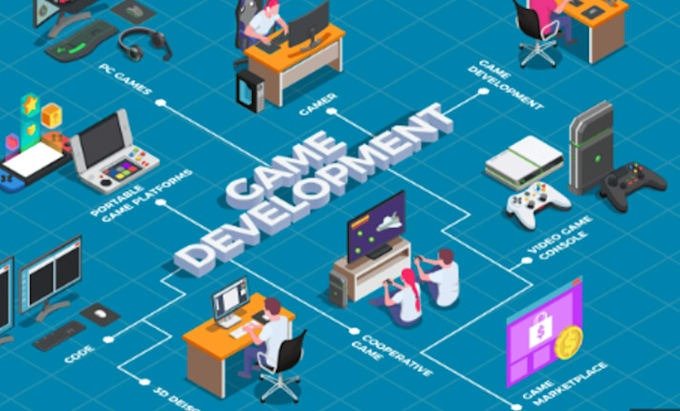





Game Development
Game development is a multidisciplinary field that brings together art, storytelling, music, and computer science to create interactive digital experiences. From humble beginnings in the early 1970s to today’s multi-billion-dollar global industry, game development has evolved into a complex and richly creative process. It encompasses not only the technical aspects of programming but also the artistic challenges of designing immersive worlds and engaging narratives.

The Game Development Process
Game development is typically divided into several key phases:
1. Concept and Pre-Production
This is where the idea for the game takes shape. Developers outline the core gameplay mechanics, story, setting, and characters. A Game Design Document (GDD) is often created to detail these elements.
During pre-production, the team decides:
The genre and platform(s) (e.g., PC, console, mobile)
Technical requirements and tools
Team size and roles
Budget and timeline
2. Production
This is the most labor-intensive phase, where the actual development takes place. Key components include:
Programming: Developers write the code that powers the game. Game engines like Unity, Unreal Engine, and Godot are commonly used.
Art and Animation: Artists create characters, environments, textures, and user interfaces. Animators bring characters and elements to life through movement.
Design: Game designers refine mechanics, level design, progression systems, and balance to ensure engaging gameplay.
Sound Design and Music: Audio professionals create sound effects and compose original music, adding emotional depth and immersion.
Writing: Writers develop dialogue, lore, and narrative structure.
3. Testing (Quality Assurance)
QA testers identify bugs, glitches, and gameplay issues. They ensure that the game runs smoothly across different devices and meets performance expectations. This phase often involves iterative testing and polishing.
4. Launch
Once the game is complete and tested, it is released to the public. This may include:
Publishing on platforms like Steam, PlayStation Network, Xbox Live, or the App Store
Marketing campaigns
Trailers, demos, or early access versions
5. Post-Launch Support
Modern games often continue evolving after release. Developers may issue patches, updates, downloadable content (DLC), and expansions. Online games receive ongoing support, including server maintenance and new content drops.
Key Roles in Game Development
Game development is a collaborative process involving professionals from various backgrounds:
Game Designers: Create the vision, rules, and mechanics of the game.
Programmers: Implement functionality using programming languages like C++, C#, Python, or Lua.
Artists: Create 2D and 3D assets, concept art, and user interfaces.
Animators: Produce character and environmental animations.
Sound Designers and Composers: Craft the game’s auditory experience.
Writers: Develop dialogue, backstory, and narrative arcs.
Producers: Manage the project timeline, budget, and team coordination.
QA Testers: Identify bugs and ensure gameplay quality.
Game Engines and Tools
Game engines streamline the development process by providing built-in features such as rendering, physics, scripting, and audio. Some of the most popular game engines include:
Unity: Widely used for both 2D and 3D games. Supports C# scripting and offers strong cross-platform support.
Unreal Engine: Known for high-quality graphics and used in many AAA games. Uses C++ and Blueprints (a visual scripting system).
Godot: Open-source engine with an easy-to-learn scripting language (GDScript), growing in popularity among indie developers.
GameMaker Studio: Ideal for 2D games and beginner-friendly.
Other tools used in game development include:
Blender, Maya, or 3ds Max for 3D modeling
Photoshop or GIMP for 2D artwork
FMOD or Wwise for audio implementation
Trello, Jira, or Asana for project management
Indie vs AAA Development
AAA Studios
AAA studios are large teams (often 100+ people) working on high-budget games for major publishers. These projects can take years to develop and involve sophisticated marketing campaigns. Examples include Call of Duty, Assassin’s Creed, and Horizon Zero Dawn.
Indie Developers
Indie developers are often smaller teams or solo creators. They usually have limited budgets and rely on creativity and innovation to stand out. Successful indie games like Hollow Knight, Stardew Valley, and Undertale demonstrate that great gameplay doesn’t require a huge budget.
Challenges in Game Development
Game development is a demanding field with numerous challenges:
Scope Creep: Expanding features beyond the original plan can delay release and strain resources.
Crunch Time: Long, stressful work hours near deadlines are common, though increasingly criticized in the industry.
Technical Complexity: Developing for multiple platforms, handling performance issues, and debugging are significant hurdles.
Monetization: Developers must decide how to price the game, handle in-app purchases, or support ads, especially in mobile gaming.
Market Saturation: Thousands of games are released each year, making it difficult to gain visibility without strong marketing.
The Future of Game Development
As technology continues to advance, so too does the potential of game development. Here are some exciting trends shaping the future:
Virtual Reality (VR) and Augmented Reality (AR): Games like Beat Saber and Half-Life: Alyx showcase the immersive potential of VR.
AI and Procedural Generation: Games increasingly use AI to enhance NPC behavior or generate vast, dynamic environments (Minecraft, No Man’s Sky).
Cloud Gaming: Services like Xbox Cloud Gaming, NVIDIA GeForce Now, and Google Stadia allow games to be streamed to any device with internet access.
Cross-Platform Play: More games are allowing players on different devices to play together, breaking down platform barriers.
Inclusivity and Accessibility: Developers are focusing on creating experiences for players of all abilities and backgrounds, with features like customizable controls, colorblind modes, and narrative diversity.
